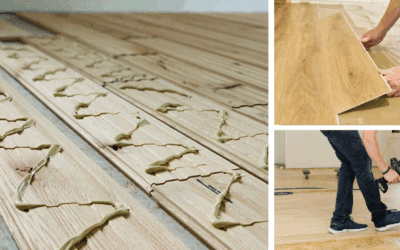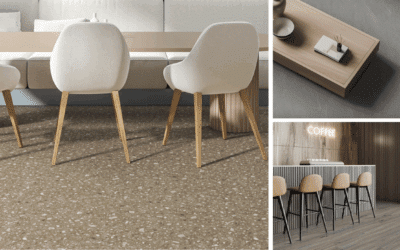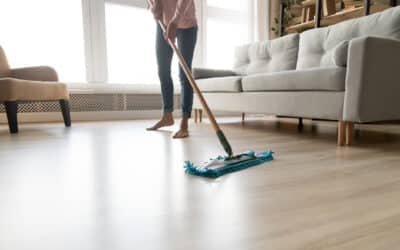The basketball court has come a long way since James Naismith nailed peach baskets to the gym railings.
From humble beginnings, the basketball court has evolved into an iconic and essential part of the game. And its allure transcends mere aesthetics: the court is an emblem of the sport’s rich history and vibrant culture.
Whether it’s a high school gym or a crowd-packed arena, the basketball court is more than just a surface. It’s a canvas upon which the dynamic game unfolds.
Engineered for unsurpassed beauty and peak performance, today’s premier basketball court flooring systems are a marvel. Costing anywhere from $80,000 – $200,000+, basketball court flooring is an investment in quality, durability, and aesthetics.
In this article, you will learn about basketball court flooring, including its characteristics, types, brands, and installation. By the end, you will have a high-level understanding about its nuance and craftsmanship.
How Basketball Court Flooring Influences the Game
The flooring quality has a direct effect on the pace and fluidity of the game. A high-quality court enables players to have precision when they’re dribbling and moving across the court.
A floor with the right amount of surface friction reduces slipping risks and allows players to maneuver swiftly and with confidence.
Shock absorption, the flooring system’s ability to absorb impact, is also important. The best court floors have 50% minimum shock absorption to reduce strain on players’ joints and minimize the risk of injuries.
Overall, basketball court flooring is an investment in the quality of play, performance, and overall safety of the players.
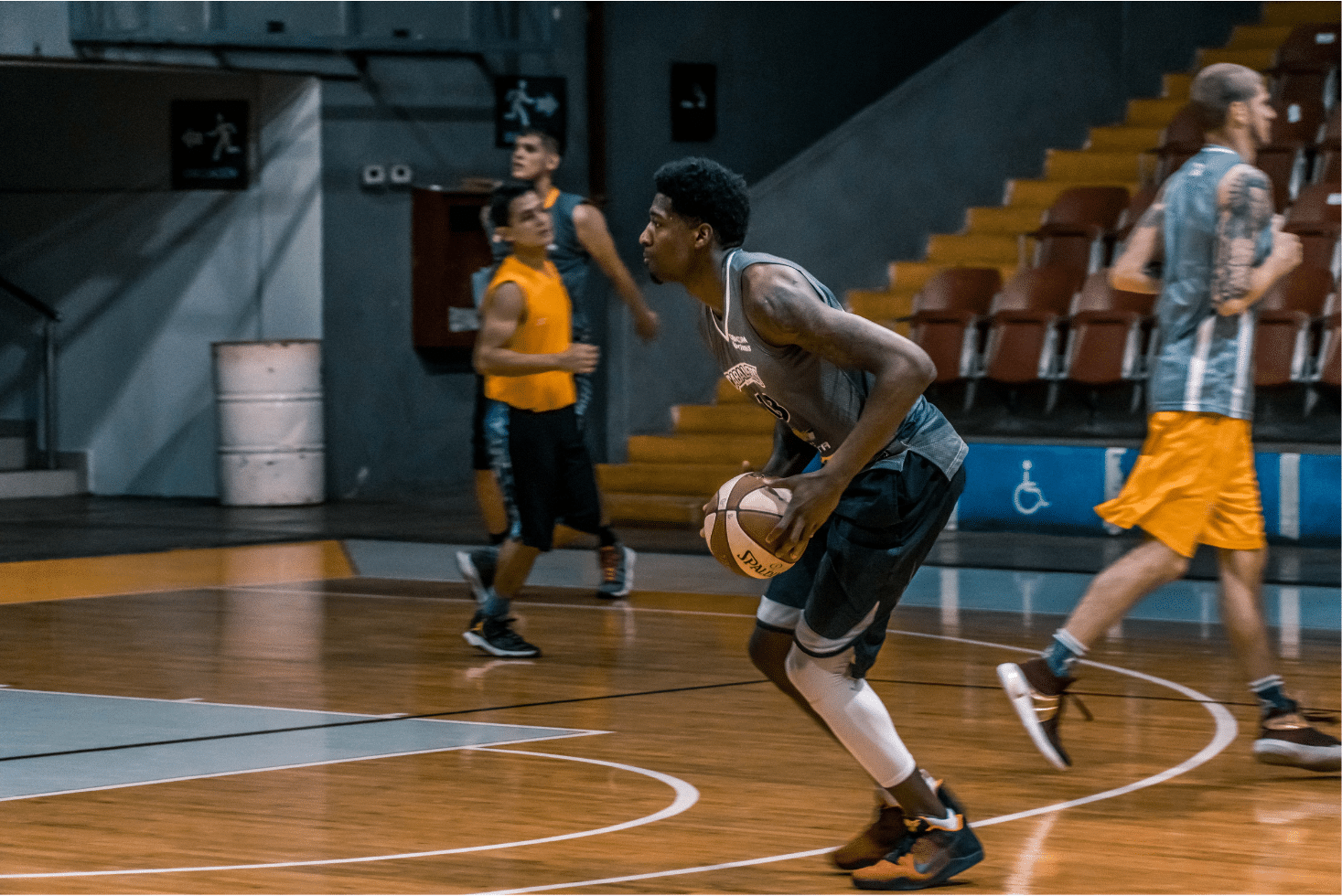
Key Characteristics of an Ideal Basketball Court Floor
Selecting a basketball court floor is typically about striking a balance between the performance characteristics you require and your budget.
You must consider many aspects relative to cost, performance, maintenance, design, and durability. What follows are the most important characteristics of a basketball court floor.
- Traction, or grip, is the frictional force that prevents players from slipping on the court surface. On a court with good traction, players can make quick movements without losing balance and maintain control during the game. On basketball courts, surface friction is the resistance between the player’s shoe and the court surface. Too much friction can lead to sprained ankles, but too little can cause players to slip.
- Consistent rebound determines a predictable and uniform ball bounce on a basketball court. This is crucial for the quality of play and fairness of the game. On a court with good rebound consistency, the ball will bounce at a similar height and speed across the entire surface. This allows players to anticipate the ball’s trajectory and plan their moves accordingly. Courts with inconsistent ball bounce disrupt the flow of the game and create chaos on the court.
- Shock absorption refers to the floor’s capacity to absorb and disperse the energy players generate during play. A basketball court with superior shock absorption lessens the force of impact players experience when they jump and land. This reduces strain on their joints and prevents potential harm to ligaments, muscles, and bones. It also mitigates fatigue, so they can perform at their best for longer periods.
- Durability is the way the court withstands the wear and tear of consistent use and intense competition. A highly durable court keeps its optimal performance over a long period.
- Deflection is the degree of give in the flooring when players apply force. When a player jumps or lands on the court, the force exerted causes the floor to compress or bend slightly. Deflection helps absorb and distribute the impact, reducing stress on athletes’ joints. An ideal court needs enough deflection to provide cushion, but not so much that it compromises the court’s stability.
- Ease of maintenance affects the longevity and cost of the court. A well-maintained court lasts longer and provides players with consistent conditions. Regular maintenance increases the total ownership cost.
- Design affects the game’s performance and aesthetic appeal. Great design includes layout of various elements, such as the court’s dimensions, markings, color scheme, logos, and flooring type. With the advent of advanced technology, installers can bring innovative designs to life on basketball courts. Using plotters that produce detailed stencils, designers can superimpose intricate graphics onto the court floor, enhancing the home court aesthetics.
Want championship-ready floors with all these attributes? Reach out to us about your sports flooring project.
Types of Basketball Flooring
Aside from asphalt or concrete courts, there are two main types of basketball court flooring: maple and synthetic.
Maple Hardwood Basketball Court Flooring
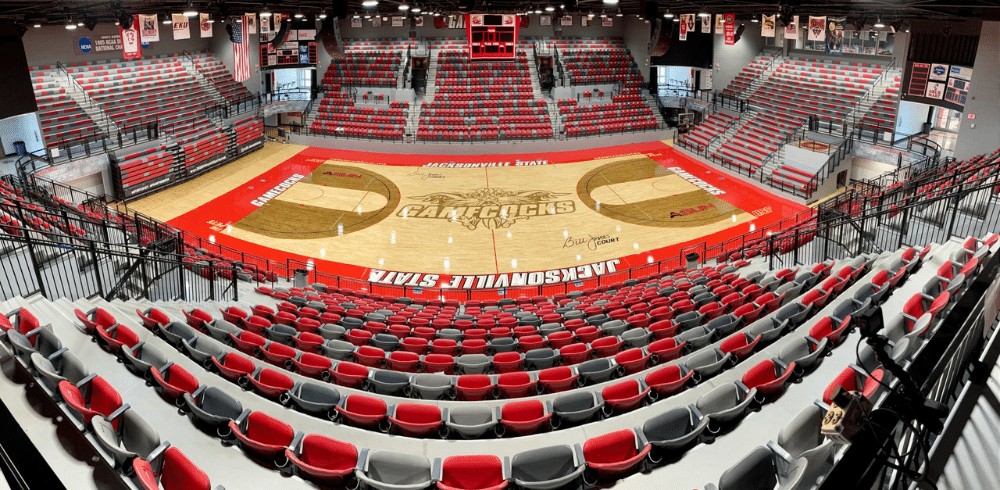
Maple hardwood is the gold standard for basketball court flooring. It offers superior performance and is the first choice for both professional and amateur arenas. The NBA demands the best playing surface possible, and maple hardwood fits the bill.
One of the primary reasons athletes prefer maple hardwood is for its excellent surface friction. The natural texture of maple provides just the right amount of grip.
The hard, dense nature of maple also promotes a predictable and uniform bounce necessary for fair play and optimal ball control.
Another significant advantage of maple hardwood is its impressive shock absorption properties. When properly installed and maintained, maple can effectively reduce the impact force experienced by athletes during jumps and landings.
Durability is yet another strength of maple hardwood. With its robust and hardy nature, this flooring can withstand the intense activity of basketball games over time.
Finally, maple hardwood is relatively easy to maintain, requiring standard cleaning and occasional refinishing to keep it in top condition. This makes it a cost-effective solution over its lifetime, despite the higher upfront costs compared to synthetic flooring options.
The MFMA represents the worldwide industry for maple basketball courts. The MFMA rates maple floors using PUR Standards. These standards are pass/fail and measure shock absorption, vertical deflection, area of deflection, basketball rebound, and surface friction.
A Classic Design Appeals to Players & Fans
Maple hardwood offers a classic, professional look that enhances the aesthetic appeal of any basketball court. The light, natural hue of the wood provides a stark contrast with court markings and the ball. And this helps ensure clarity during fast-paced games.
The natural beauty of maple is well-known for its iconic look, and fans recognize it from around the world. It offers a sense of tradition and prestige, enhancing the spectator experience.
Overall, maple hardwood’s characteristics, durability, ease of maintenance, and aesthetic appeal make it the premier choice for basketball court flooring.
Despite its high initial cost and maintenance requirements, maple is the professional choice for indoor basketball court flooring. However, it’s not the only option available. Multi-purpose synthetic flooring is gaining traction for its lower cost and easier maintenance.
Synthetic Basketball & Multi-Sport Flooring

Multi-purpose synthetic basketball court flooring is a popular alternative to traditional hardwood. Made from advanced materials like polyurethane or vinyl, synthetic sports flooring offers durability and performance at a lower price point.
Engineered to withstand heavy use and adverse weather conditions, this flooring is suitable for both indoor and outdoor basketball courts.
Compared to maple hardwood, synthetic flooring is versatile. You can install it over various subfloor types and adapt it to different sports. Synthetic flooring also offers a wide array of design options, giving you more design flexibility than traditional maple hardwood.
Though synthetic flooring isn’t at the same level as maple hardwood, advancements in technology have significantly bridged the gap. Many high-quality synthetic floors deliver excellent grip and uniform ball bounce, ensuring a satisfying playing surface.
The shock absorption capabilities of synthetic flooring are also worth noting. Some synthetic floors feature cushioned underlays or shock-absorbing layers to provide an added level of comfort and safety.
Synthetic flooring also offers great resistance to wear and tear, moisture, and UV. It’s low maintenance, requiring only regular cleaning without the need for refinishing.
Although maple hardwood remains the top choice, multi-purpose synthetic basketball court flooring is a versatile and cost-effective alternative. This makes it an increasingly popular choice for basketball court installations in schools, community centers, and rec centers.
Synthetic floors use a different evaluation standard, such as DIN and CEN, which vary in criterion, depending on the sport.
Compared to maple, synthetic floors aren’t the best option for basketball courts, but they come with many benefits. They work well for multiuse, including sports with spikes and wheels. And they offer more design possibilities with colors and contrasts. They’re also easier to clean, and can have varying levels of shock absorption, depending on your needs.
Top Basketball Court Flooring Brands
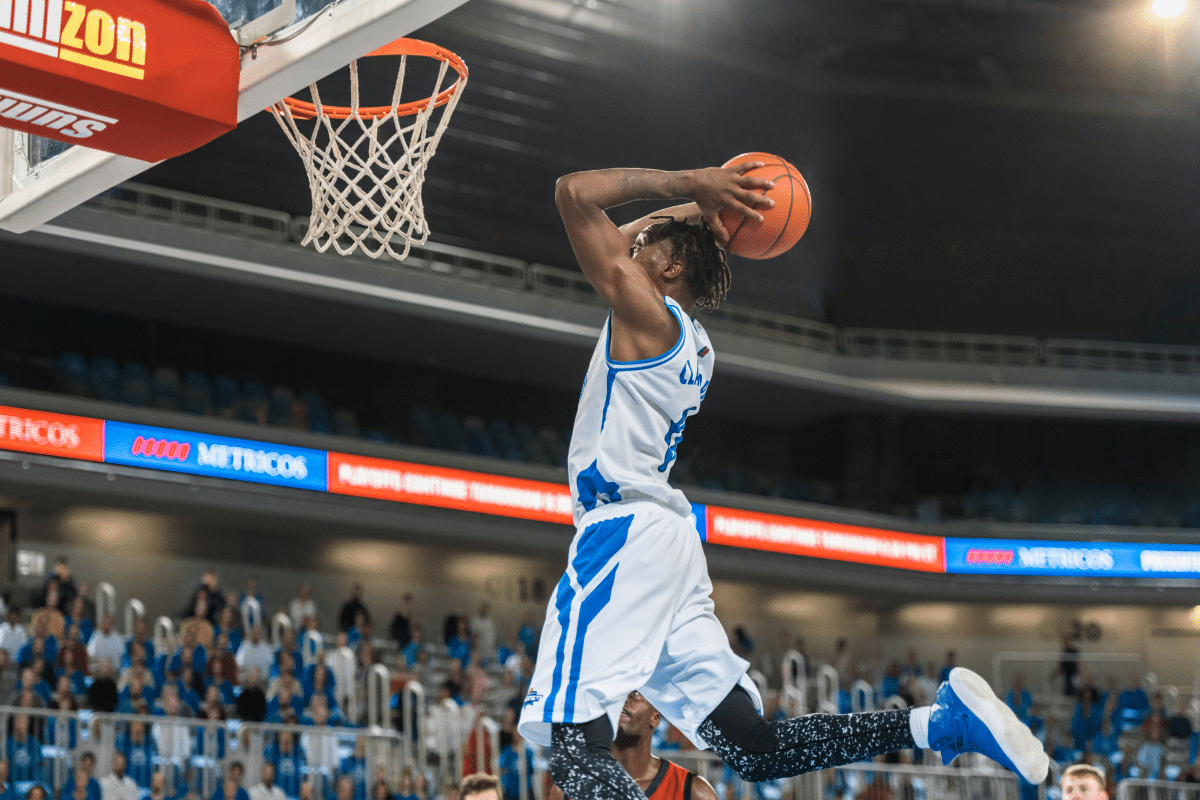
In today’s market, a myriad of court flooring options exist, with each brand offering their own set of comparable flooring systems. Connor Sports, Robbins, and SnapSports are three well-known brands in the sports flooring industry.

Connor Sports
Connor Sports stands at the forefront of sports flooring. With over 100 years of experience, they are the official court supplier for NCAA March Madness and the Final Four. You can also find many of their floors in NBA arenas.
Their commitment to vibration control, ball bounce, and ball response is evident in their Focus flooring system. Focus is one of their top basketball court flooring products. You can find an example of this flooring in action at Ohio Wesleyan University.
Connor Sports also supplies flooring to multi-court complexes, such as Ohio State’s Covelli Center. Whether you require a professional basketball court or a multi-functional sports surface, Connor Sports has you covered.
Robbins
Like Connor Sports, Robbins has a legacy spanning over 100 years. They have consistently been at the forefront of delivering innovative and superior quality basketball courts. They supplied courts for Creighton, SMU, Oregon State, Texas A & M, and even the legendary Chicago Bulls.
Beyond the world of competitive basketball, Robbins has also made a mark in the fitness industry. Their state-of-the-art courts are a common sight in fitness centers and training facilities across the NBA and NCAA.
SnapSports
SnapSports is a family-owned company and they make their floors in the USA. Specializing in both residential and commercial sports courts, SnapSports offers many design, color, and surface options. And they offer permanent or portable courts. Uniquely engineered to be impervious to humidity and moisture, these courts maintain a high-performance level in all weather conditions.
They design courts (even backyard basketball courts) that host multiple sports, from basketball and volleyball, to inline hockey, futsal, handball, and racket sports. What sets SnapSports apart is their modular tiles that interlock using patented Outdoor Revolution technology, ensuring seamless installation and excellent performance. The integrated traction surface provides superb dry traction and consistent ball bounce, enhancing the player experience.
What Does it Take to Install a Professional Basketball Court Floor?
Installing a professional basketball court is an intricate process that requires both expertise and precision.
The process entails installing plywood blocking, sanding the surface, staining, sealing, painting the lines, logo, and finally, applying the finish. The meticulous attention to the process and every last detail ensures the ultimate playing surface for athletes.
The enormity of basketball court flooring projects is evident in the significant time investment and work involved. Preparation alone can demand up to 15 hours and yield 700 lbs of sawdust!
Leading sports flooring brands hire experienced flooring professionals, such as Foster and The Ohio Floor Company, to install basketball courts. Notably, The Ohio Floor Company crafts floors every year for the NCAA March Madness tournament.
Foster has many impressive completed courts showcased in their online gallery.
The Ohio Floor Company has been a trusted name in flooring since 1984, taking on notable projects like refinishing the 10,890 sq. ft court at Indiana Tech, which took 413 hours and 62 gallons of sealer and finish. You can see their process at work in the video below.
Summary
Basketball thrives on fast breaks, smooth shots, swift passes, and sky-high feats. Every sprint, pivot, dive, leap, and release is a testament to the game’s skill, intensity, and competition. And the court quality determines players’ performance, safety, and comfort.
Traction, consistent rebound, shock absorption, durability, deflection, ease of maintenance, and design are the key characteristics of a high-quality court. And they vary depending on the flooring.
Maple wood is the most popular choice for indoor flooring because of its timeless charm and exceptional functionality. However, synthetic flooring is gaining popularity for facilities that host various sporting activities.
Making the right flooring investment requires careful thought. You’ll need to consider factors like cost, performance, maintenance, design, and durability. With so many options at various price points, every decision counts.
On your journey to select the perfect flooring, you may encounter three top contenders – Connor Sports, Robbins, and SnapSports. Connor Sports is a key player in the industry, supplying courts for NCAA March Madness and several NBA teams.
Robbins brings a century-long legacy and is the preferred choice for major organizations and teams. And if you’re looking for something unique in both residential and commercial sports courts, SnapSports offers an innovative modular tile system.
The installation of a professional basketball court floor is no small feat. It’s a meticulous process that requires expertise and precision, with companies like The Ohio Floor Company offering top-tier services. From preparation to installing plywood blocking, sanding, staining, sealing, painting lines and logos, and applying the finish – every step matters.
Overall, choosing the right basketball court flooring is a critical decision that impacts not only the aesthetics of your facility but also the performance and safety of the players. Whether you opt for the prestige of maple wood or a versatile synthetic alternative, ensuring your choice aligns with your needs and budget is paramount. Consider your options wisely as your decision will influence many games to come.

